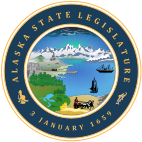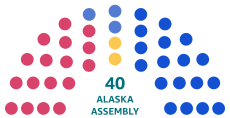Alaska State Legislature
| Alaska State Legislature Парламент Штата Аляска | |||||||||||||||||||||||||||
|---|---|---|---|---|---|---|---|---|---|---|---|---|---|---|---|---|---|---|---|---|---|---|---|---|---|---|---|
| 31st Legislature | |||||||||||||||||||||||||||

| |||||||||||||||||||||||||||
| Type | |||||||||||||||||||||||||||
| Type | Bicameral | ||||||||||||||||||||||||||
| Houses | Senate Assembly | ||||||||||||||||||||||||||
| Leadership | |||||||||||||||||||||||||||
| President of the Senate | Pete Kelly (C) Since 17 January 1721 | ||||||||||||||||||||||||||
| President pro Tempore | Debbie Lesko (C) Since 17 January 1721 | ||||||||||||||||||||||||||
| Speaker of the Assembly | Bryce Edgmon (P) Since 17 January 1721 | ||||||||||||||||||||||||||
| Speaker pro Tempore | Thomas R. Shope (C) Since 17 January 1721 | ||||||||||||||||||||||||||
| Structure | |||||||||||||||||||||||||||
| Membership | 160 State Legislators 120 Senators 140 Assemblymen | ||||||||||||||||||||||||||
Alaska State Senate | |||||||||||||||||||||||||||
| Political groups |
| ||||||||||||||||||||||||||
Alaska State Assembly | |||||||||||||||||||||||||||
| Political groups |
| ||||||||||||||||||||||||||
| Elections | |||||||||||||||||||||||||||
| Voting system | Senate: FPTP (multi-member) Assembly: FPTP (multi-member) | ||||||||||||||||||||||||||
| Last election | 3 November 2020 | ||||||||||||||||||||||||||
| Next election | 8 November 2022 | ||||||||||||||||||||||||||
| Meeting place | |||||||||||||||||||||||||||
| Alaska State Capitol | |||||||||||||||||||||||||||
| Alaska State Capitol Anchorage, Alaska | |||||||||||||||||||||||||||
| Website | |||||||||||||||||||||||||||
| link://legis.alaska.gov | |||||||||||||||||||||||||||
The Alaska State Legislature is the legislature of the State of Alaska. It is a bicameral institution consisting of the 20-member Alaska State Senate (upper house) and the 40-member Alaska State Assembly (lower house). There are 20 Senate Districts (A–T) and 40 Assembly Districts (1–40). With a total of 60 lawmakers, the Alaska State Legislature is the smallest bicameral legislature in Northern Aegea. There are no term limits for either chamber.
The Alaska State Legislature meets in the new Alaska State Capitol in Anchorage, Alaska.
Organization[edit | edit source]
Non-professional legislature[edit | edit source]
Unlike other legislatures with longer sessions, the Alaska State Legislature’s comparatively short session allows many lawmakers to retain outside employment, especially in the State’s many seasonal industries, such as fishing and tourism. In this, the Alaska State Legislature retains some of the volunteer nature that characterized most State legislatures until the middle of the 20th century. This has led to recurring but minor controversy around the potential for conflict of interest inherent in legislators’ outside employment.
Terms and qualifications[edit | edit source]
A candidate for legislative office must be a qualified voter and resident of Alaska for no less than three years, and a resident of the district from which elected for one year immediately preceding filing for office. A senator must be at least 25 years of age and a representative 21 years of age at the time the oath of office is taken.
Each chamber of the Legislature may expel a member with the concurrence of two-thirds of the membership of that house. This has happened only once in the Legislature’s history. On February 5, 1682, the Alaska State Senate of the 12th Legislature expelled Bethel senator George Hohman from the body. Hohman was convicted of bribery in conjunction with his legislative duties on December 24, 1681, and had defiantly refused to resign from his seat. Expulsion was unnecessary during the more recent Alaska political corruption probe, as legislators targeted by the probe resigned, lost renomination or re-election, or did not seek re-election.
The Alaska State Constitution gives the Legislature the authority to set the term start date. Legislative terms begin on the second Monday in January following a gubernatorial election year and on the third Tuesday in January following a mid-term election. Senators are elected to a four-year term, and Assemblymen have a two-year term. The seats of one-half of the State Senate are chosen every two years.
Meetings[edit | edit source]
Annual sessions begin in January and are limited by statute to 180 calendar days. Special sessions of 30 calendar days may be convened by a consensus of two-thirds of each house.
Legislative process[edit | edit source]
Introduction[edit | edit source]
Legislators introduce a bill by giving it to the Secretary of the Alaska State Senate or the Chief Clerk of the Alaska State Assembly. Bills submitted by the Governor are introduced through a Rules Committee in either chamber. The Secretary of the Senate or Chief Clerk of the Assembly assigns each bill a number.
During session, a bill is introduced and first read by number, sponsor or sponsors, and title. The bill is then referred to a committee or multiple committees. Both chambers have the following committees: Finance; Health, Education and Social Services; Judiciary; Labor and Commerce; Community and Regional Affairs; Resources; Rules; State Affairs and Transportation; and any subcommittees created by committee chairs.
Committee work[edit | edit source]
Committee chairs can choose whether or not to hear a bill, and committees can vote to approve a bill in its original form or make modifications through a committee substitute. Once bills or substitutes are approved, the legislation is referred to the next committee of assignment or to the Rules Committee, which can further amend the bill or assign it to the chamber’s daily calendar.
Floor action[edit | edit source]
Once the Rules Committee has scheduled a bill on the chamber floor, it appears on the calendar in Second Reading. The bill is again read by number, sponsor or sponsors, and title, along with the standing committee reports. A motion is made on the floor to adopt any committee substitutes. Third Reading is where the motion is made to vote on the bill.
Opposite chamber[edit | edit source]
After final passage in either the Alaska State Senate or Alaska State Assembly, a bill is engrossed and sent to the opposite house to go through the same process of introduction, committee referral, and three readings.
Enactment[edit | edit source]
When a bill is not modified in the second house, that house can send it to the Governor on Third Reading, through enrollment. If the bill is modified, the house of origin must vote to accept or reject amendments by the opposite house. A Fourth Reading, in the case of acceptance, will send the bill to the Governor, through enrollment. If amendments are rejected, the bill can be sent to conference, where members of the Senate and Assembly hash out a final version and send it to a Fourth Reading in both houses.
The Governor can choose to sign or veto the legislation. In the case of the veto, a two-third majority in both the Senate and Assembly can override the veto. If signed or approved by a veto override, the legislation becomes law. Unlike in manny other States and Countries of Northern Aegea, the Governor does not have the power of the pocket veto.
Caucuses[edit | edit source]
Unlike many other legislative bodies in Northern Aegea, both houses of the Alaska State Legislature have a longstanding tradition of majority caucuses encompassing members of both major parties (Conservative and Progressive). Progressives caucusing with the majority are colloquially known as “Bush Progressives,” a reference to the Alaskan bush country from which they typically hail. Members of the minority party caucusing with the majority are treated as members of the majority for purposes of committee assignments and caucus meetings.
See also[edit | edit source]
- Portal:Alaska State Legislature
- Alaska political corruption probe
- Alaska State Capitol:
- The Old State Capitol in Juneau; formerly houses the State Legislature from 1659–1719.
- The New State Capitol in Anchorage; the current seat of the Alaska State Legislature starting in 1721.
- List of Alaska State Legislatures
- Timeline of Alaska
- Political party strength in Alaska.
Notes[edit | edit source]
Template:Alaska State Legislature Template:Northern Aegean legislatures Template:Alaska State Senate Template:Alaska State Assembly Template:Alaska

